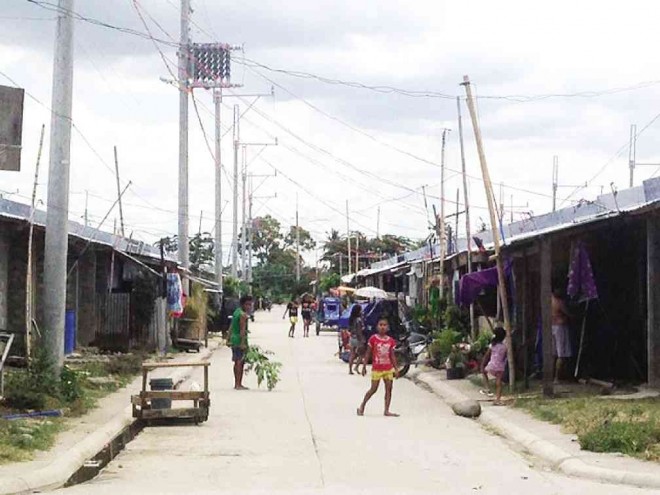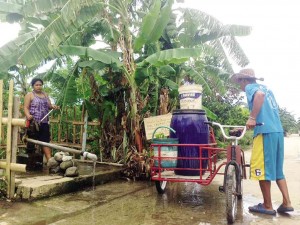Makati’s poor: ‘We were dumped here’

THE 40-HECTARE Makati Homeville relocation site in Barangay Dayap, Calauan, Laguna, is a project of the Makati City government. It houses some 650 families, who used to be Metro’s poor urban dwellers. PHOTOS BY MARICAR P. CINCO/ INQUIRER SOUTHERN LUZON
CALAUAN, Laguna—Some 650 families, who used to live along waterways, disaster-risk zones and private lots in Makati City, made their choice six years ago.
Rather than take the P18,000 cash and return to their home provinces, they opted to be relocated to this town, about 70 kilometers away, through the Makati City’s housing program.
But it wasn’t what they had expected.
“We thought (the house) would be like the blue model house we were shown, with pipelines ready for the water (supply),” said Rosie Quilantang, 51, a relocatee at the Makati Homeville in Barangay Dayap here.
The 40-hectare Makati Homeville, intended for Makati’s relocated urban poor dwellers, was a project of former Makati City mayor and now Vice President Jejomar Binay. Binay who, during the Senate blue ribbon subcommittee hearing last week, was accused of earning P1 billion in kickbacks from the housing project.
Houses
“They used to live in shanties and were relocated (to Laguna) to live, again, in shanties,” said a volunteer social worker who refused to be named for fear of reprisal.
There were no houses waiting for the families when they moved into the relocation site in 2009.
Quintalang said they had to build their houses on their own, using the same materials from the houses demolished in Makati City. There was also no electric and water supply and a ready source of livelihood.
“We we’re dumped here with nothing to live on,” Quilantang said.
It was about four years later, or in 2013, when the Makati government completed the construction of a few hundred housing units. To date, 395 families (out of 650 families currently on site) are residing in the concrete bungalows, while the rest are still living in houses made of light materials.
Each house, with floor area ranging from 40-60 square meters, has its own bathroom and a toilet. The walls are bare concrete blocks while the roofs are made of iron sheets without ceilings.
“It’s so hot in here specially during this time of the year,” said resident Kathleen Mercadero, 18.
Water is sourced from deep wells placed in almost every block. And until last month, electricity was not available.
Quintalang said it was only about a month ago that power was installed and for just about 200 households.

A COUPLE fetches water from a deep well inside the Makati Homeville resettlement site in Dayap. The housing project was recently mentioned in the continuing Senate investigation on the alleged corrupt practices that involved the family of Vice President Jejomar Binay.
‘Masapang girls’
Most male residents are the so-called “weekenders,” going home to Laguna only during the weekends since their jobs, mostly either as drivers or construction workers, are in Manila.
The women, on the other hand, earn through Makati City government’s “cash-for-work” programs, as street sweepers or camote (sweet potato) vendors.
Some residents claimed life was so hard in the resettlement that it forced some women into prostitution.
Sam, a male teen, said he knows a lot of young girls who are known as “Masapang girls.”
These girls, he said, frequent Masapang, a known junction on the boundary of Calauan and Victoria towns, to engage in prostitution “for whatever price, some even for (a can of) sardines or (a bottle of) soda.”
Marijuana, Sam also said, is readily available inside the resettlement for P50 per small bag.
‘In due time’
A 2007 Makati City council resolution, on the city government’s website, authorized Binay to acquire “several parcels of land located in Barrio Santol, Barangay Dayap” for a housing program for Makati’s urban poor. The land, it said, had a total area of 400,418 square meters and was covered by 16 transfer certificate titles. The property was acquired from a certain Nicia S. Ramos and Wilbert S. Ramos but did not say how much it cost.
“The titles are still under the city government,” said Maribel Lumang, a Makati city social welfare development officer.
She said they decided to hold the title distribution after some families traded for a sum their rights over the house or the lot.
“But we will (distribute the land titles) in due time,” she said, adding that more houses would be built but could not say when.
Free lots
The Makati Homeville project targets 6,000 families as beneficiaries. Since 2009, the project listed 1,031 families for relocation, but has moved only 650.
Asked why this is so, Lumang said “other beneficiaries who have jobs and could afford (apartments), opted to rent elsewhere.”
Lumang said the relocatees were initially promised free lots in Laguna.
Later, the Makati government considered tying up with the nongovernment organization Habitat for Humanity to build houses for the families, but they realized that this would entail costs for the beneficiaries.
The beneficiaries are not paying for the lot or the house. “The city government did not want to burden the relocatees (with monthly fees) so it instead decided to shoulder (the cost) of the construction (of the houses),” she said.
But when the project began, the city government prioritized constructing roads, a gymnasium, a clinic, a chapel, an elementary school building (now with 500 students) and a high school building inside the compound. The high school, a two-floor building, has not yet been operational since.
Lumang said some of the families, with relatives working abroad, opted to build their own houses rather than wait for the city government.
Laguna voters
Lumang said she found it unfair to say that the living conditions were poor. “How could they say there’s no water? All it needs is a little effort to fetch water from the deep wells,” she said.
On the alleged prostitution, she said her office has no knowledge about it. She insisted that they promote family- and values-oriented programs for the relocatees.
The Makati Homeville residents remained registered voters of Makati City during the 2010 and 2013 election years, enjoying the same benefits in Makati like a health card even when they were already in Laguna.
It was only in 2014, Lumang said, that they started requiring relocatees to register as Laguna voters “so they could avail of the benefits of the local government here.”
Asked why only in 2014, “at first, they did not want to give up (their Makati citizenship) perhaps because of the feeling of being separated (from their original residence),” Lumang said.
But a male resident, who refused to be identified, believed politics played a big role inside the resettlement project. “People here are divided between the pro-Mercado and pro-Binay, depending on who you talk to,” he said.
For instance, he said, the two residents, Edison Rivera and Domingo Arcilla, who recently testified in the Senate, are “pro”-Ernesto Mercado.
Mercado, a former vice mayor of Makati, was the one who blew the whistle against Binay’s alleged corrupt practices, prompting the Senate investigation.
“People will stick to whoever is in power. That’s as long as they get something in return,” the resident added.














